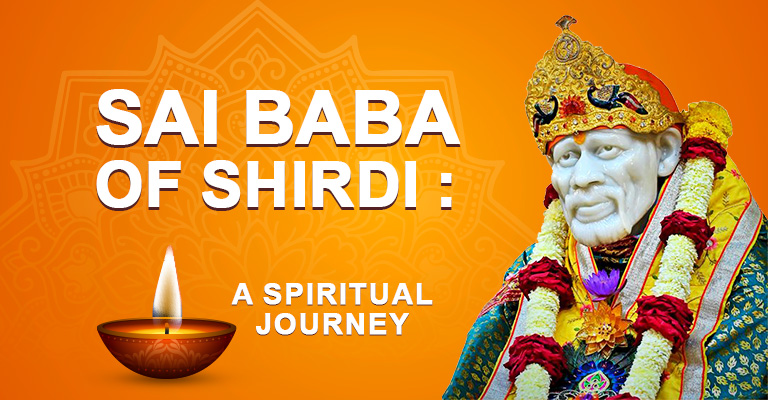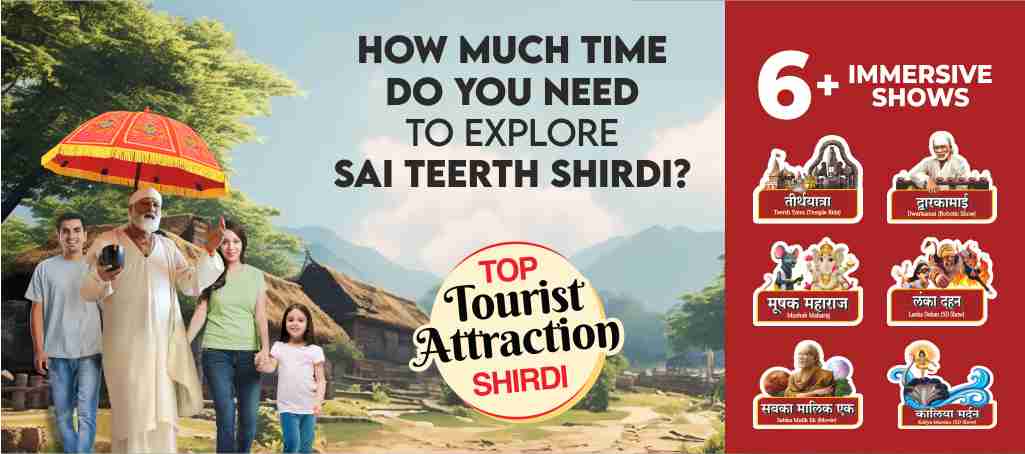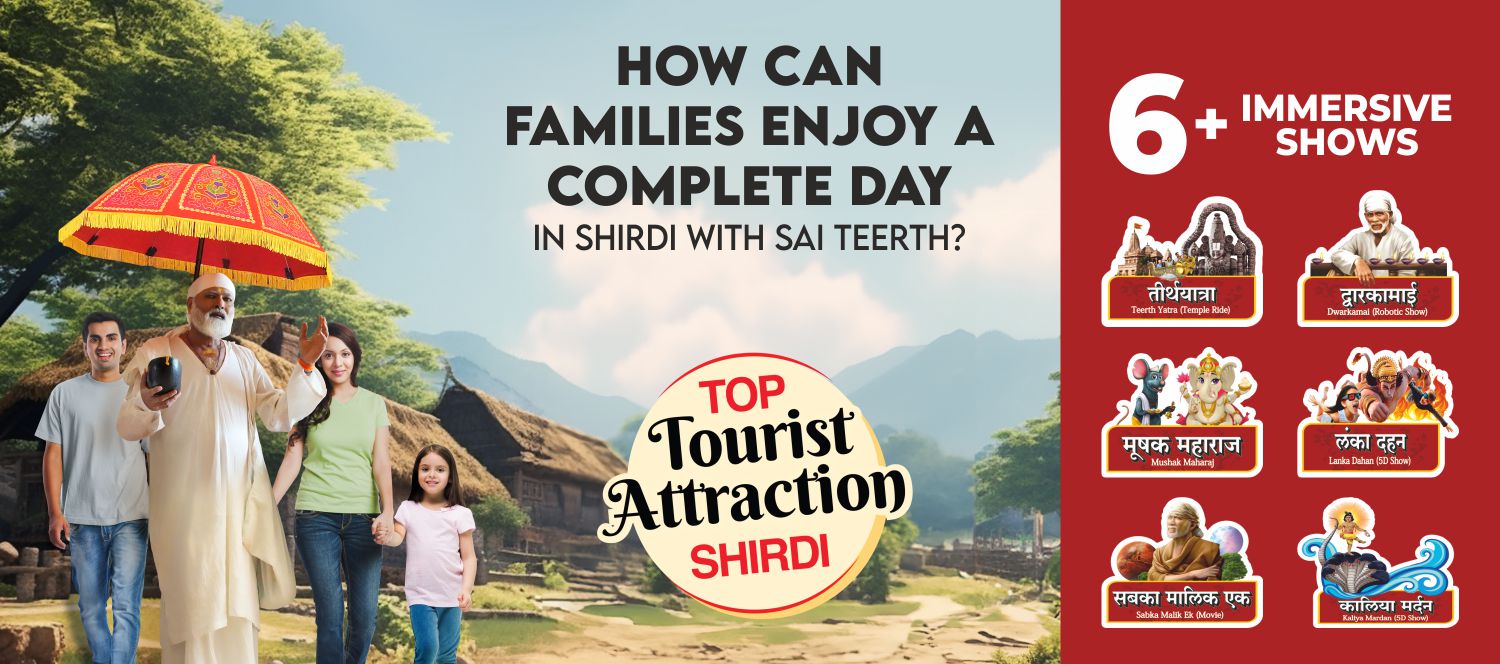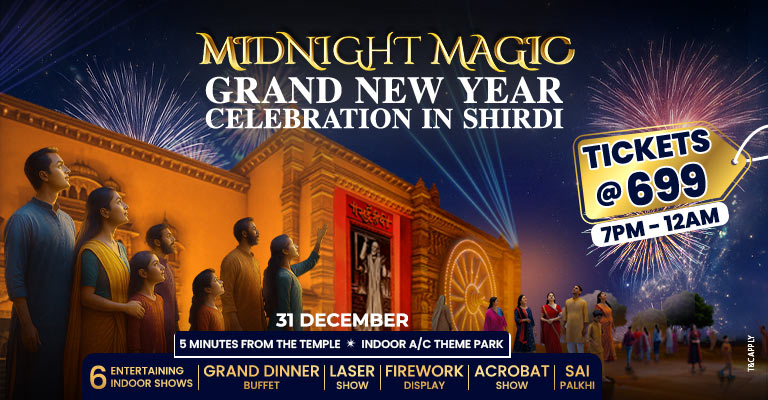Where It All Began:
Even though Sai Baba is globally known for Sai Miracles, his place and date of birth are unknown. Arriving at the village of Shirdi when he was about sixteen years old, he led a simple life, sitting motionless under a neem tree and meditating while sitting in an asana. His early life and background are surrounded in mystery just like the mysteries of the stories of Sai Baba along with his real name. The name Sai was given to him by the temple priest Mhalsapati when he returned to Shirdi in 1858. Baba is an honorific signifying grandfather, father, old man or sir.
Sai Baba lived under a neem tree for four to five years and then took up residence in an old and dilapidated mosque. Maintained a sacred fire (Dhuni), and gave sacred ash (Udi) from the fire to guests on their departure. It is also believed that he has tended a garden called Lendi Baug. Sai Baba’s teachings and philosophy continue to inspire millions of people around the world. His message of love, compassion and selfless service has been embraced by people of all religions and backgrounds. Sai Baba was known for his simple lifestyle, his love of humanity and his miraculous powers.
Sai Baba was greatly revered by many saints and spiritual leaders, including Sri Beedkar Maharaj and Vasudevananda Saraswati. He is considered an avatar of the ‘Supreme Reality’ and a saint in Hinduism. Prominent Zoroastrians such as Nanabhoy Palkhivala, Farhaad Panthaky and Homi Bhabha also revered Sai Baba.
Significance:
Sai Baba’s first devotee was a local Khandoba priest, Mhalsapati Nagre. Today, Shirdi has become a place of importance in India and is counted among the major pilgrimages. The Sai Baba Temple in Shirdi is visited by an average of 25,000 pilgrims a day and is managed by the Shri Sai Baba Sansthan Trust. Four aartis are held daily inside the Samadhi Mandir and the Palanquin procession of Sai Baba takes place every Thursday. Sai Baba of Shirdi is especially revered and worshiped in the states of Maharashtra, Odisha, Andhra Pradesh, Telangana, Karnataka, Tamil Nadu and Gujarat.
It is said that Sai Baba had told his devotees that he would soon be ‘leaving his mortal body’. Towards the end of September, he had high fever and stopped eating. Sai Baba died in 1918, but his legacy continues to inspire people around the world. He is considered a saint by Hindus, Muslims and people of all faiths.
Sai Baba’s teachings were based on the principles of love, compassion and service to others. He taught that all religions are paths to the same God and he emphasized the importance of living a simple and virtuous life.
- Here are some of the key points about Sai Baba’s life and teachings:
- His early life is shrouded in mystery.
- He was brought up by a Fakir.
- He arrived at the village of Shirdi in 1858.
- He took up residence in an old and dilapidated mosque.
- He was known for his simple lifestyle, his love of humanity and his miraculous powers.
- His teachings were based on the principles of love, compassion and service to others.
- He died in 1918, but his legacy continues to inspire people around the world.
Sai Baba of Shirdi, also known as Shirdi Sai Baba, is a beloved saint who has touched the hearts of millions with his teachings of love, compassion, and selflessness. Shirdi, a small town in Maharashtra, is the place where he lived and taught, making it a significant spiritual destination. This blog will guide you through the key places to visit in Shirdi, the role of the Shri Sai Baba Sansthan Trust, and the main festivals celebrated in honor of Sai Baba.
-
Key Places to Visit in Shri Kshetra Shirdi
-
Shri Sai Baba Samadhi Mandir: This temple is the main attraction in Shirdi and is the final resting place of Sai Baba. It has a peaceful atmosphere filled with devotion, attracting thousands of visitors daily.
-
Dwarkamai: Once a mosque, Dwarkamai is where Sai Baba spent much of his life. It features an eternal flame (Dhuni) that symbolizes his teachings and is a focal point for many devotees.
-
Chavadi: This is where Sai Baba would rest every alternate night. The Chavadi is beautifully decorated and provides a glimpse into Baba’s simple lifestyle.
-
Shri Sai Baba Museum: Located near the Samadhi Mandir, this museum displays various artifacts, photographs, and belongings of Sai Baba, giving visitors insight into his life and teachings.
-
Lendi Baug: This serene garden is where Sai Baba used to take walks. It is filled with trees and flowers, making it a perfect spot for meditation and reflection.
Shri Sai Baba Sansthan Trust
The Shri Sai Baba Sansthan Trust manages all activities and facilities in Shirdi. Established to serve the needs of devotees, the trust provides various services, including accommodations, meals, and healthcare. They ensure that every visitor has a smooth and spiritual experience, maintaining the sanctity of Sai Baba’s teachings.
Major Festivals Celebrated in Shirdi
Shirdi comes alive during many festivals that reflect Sai Baba’s spiritual legacy. Here are some key celebrations:
-
Shri Ram Navmi Utsav: Celebrated in March or April, this festival marks the birth of Lord Rama, with special prayers and processions in the temple.
-
Shri Guru Pournima: This festival honors spiritual teachers, with devotees offering prayers and seeking blessings from Sai Baba.
-
Shri Samadhi Anniversary (Vijaydashami / Dussehra) Utsav: In October, this festival commemorates the day of Sai Baba’s samadhi, featuring special rituals and celebrations.
-
Thursday Palkhi: Every Thursday at 9:15 PM, a palkhi (palanquin) procession takes place, allowing devotees to participate in a special darshan.
-
Mahashivaratra: Celebrated in February or March, this festival honors Lord Shiva with special prayers and rituals.
-
Rangpanchami: A joyous festival celebrated in March with colors.
-
Gudhi Padwa: Marking the New Year for Maharashtrians, this festival includes special prayers and offerings to Sai Baba.
-
Hanuman Jayanti: Celebrating the birth of Lord Hanuman with special prayers and gatherings.
-
Shravani Monday: A day for special prayers dedicated to Lord Shiva.
-
Gokulashtami: Celebrated in August, marking the birth of Lord Krishna with joyous festivities.
-
Narak Chaturdashi: Known as Choti Diwali, marked by special rituals and prayers.
-
Deepawali: This festival of lights is celebrated with enthusiasm, including decorations and offerings to Sai Baba.
-
Tulsi Wedding Programme: A unique celebration involving a symbolic wedding of the Tulsi plant.
-
Shri Datta Jayanti: Celebrated in December, this festival honors Lord Dattatreya with special prayers.
Sai Baba’s Miracles
Sai Baba is also known for his miraculous deeds. Here are a few notable miracles:
Miracle of Sai Baba and Chand Bhai’s Horse
Chand Bhai, a village headman, lost his horse and searched for it everywhere. Frustrated, he met a fakir (holy man) who advised him to look near a nearby stream. Miraculously, Chand Bhai found his horse there. Impressed, he invited the fakir to his home. Later, during a marriage procession in Shirdi, the fakir was welcomed as “Sai,” which is how Sai Baba got his name.
Miracle of Lighting Lamps with Water
One day, Sai Baba was unable to get oil to light the lamps in the mosque. Instead of giving up, he poured water into the lamps and lit the wicks. To everyone’s amazement, the lamps burned brightly all night. This miracle showed the power of faith and devotion.
Miracle of Stopping the Rain
Once, a couple visiting Shirdi faced a heavy storm as they prepared to leave. Sai Baba prayed for their safe passage, and the rain miraculously stopped, allowing them to return home safely.
Conclusion
Shirdi, the home of Sai Baba, is a place where spirituality and devotion come alive. With its sacred sites, vibrant festivals, and the profound miracles of Sai Baba, it offers a unique experience for every visitor. Whether you explore the temples, join in the celebrations, or simply enjoy the peaceful atmosphere, Shirdi promises a spiritual journey that will stay with you long after your visit.
If you’re looking for a deeper experience of Sai Baba’s miracles, be sure to visit the Sai Teerth Devotional Theme Park in Shirdi, where you can enjoy the “Sabka Malik Ek” show. It’s an unforgettable experience that brings Sai Baba’s teachings to life!
-










